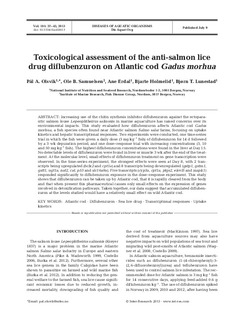Toxicological assessment of the anti-salmon lice drug diflubenzuron on Atlantic cod Gadus morhua
Journal article, Peer reviewed

View/
Date
2013-07-09Metadata
Show full item recordCollections
- Articles [3011]
Original version
Olsvik PA, Samuelsen OB, Erdal A, Holmelid B, Lunestad BT (2013) Toxicological assessment of the anti-salmon lice drug diflubenzuron on Atlantic cod Gadus morhua. Dis Aquat Org 105:27-43 10.3354/dao02613Abstract
Increasing use of the chitin synthesis inhibitor diflubenzuron against the ectoparasitic salmon louse Lepeophtheirus salmonis in marine aquaculture has raised concerns over its environmental impacts. This study evaluated how diflubenzuron affects Atlantic cod Gadus morhua, a fish species often found near Atlantic salmon Salmo salar farms, focusing on uptake kinetics and hepatic transcriptional responses. Two experiments were conducted, one time-series trial in which the fish were given a daily dose (3 mg kg–1 fish) of diflubenzuron for 14 d followed by a 3 wk depuration period, and one dose-response trial with increasing concentrations (3, 10 and 50 mg kg–1 fish). The highest diflubenzuron concentrations were found in the liver at Day 15. No detectable levels of diflubenzuron were found in liver or muscle 3 wk after the end of the treatment. At the molecular level, small effects of diflubenzuron treatment on gene transcription were observed. In the time-series experiment, the strongest effects were seen at Day 8, with 2 transcripts being upregulated (bclx2 and cpt1a) and 8 transcripts being downregulated (gstp1, gstm1, gstt1, ugt1a, nat2, cat, p53 and slc16a9a). Five transcripts (cyp3a, cpt1a, ptgs2, elovl5 and mapk1) responded significantly to diflubenzuron exposure in the dose-response experiment. This study shows that diflubenzuron can be taken up by Atlantic cod, that it is rapidly cleared from the body and that when present this pharmaceutical causes only small effects on the expression of genes involved in detoxification pathways. Taken together, our data suggest that accumulated diflubenzuron at the levels studied would have a relatively small effect on wild Atlantic cod.